Control Customization in WPF SfColorPalette
This section explains the different types of colors available in the SfColorPalette and how to choose the colors and its panel customizations.
Accessing a Color programmatically
You can set or change the selected color of the SfColorPalette programmatically by setting the value to SelectedBrush property. You can also get the selected color by using the SelectedBrush property. The default value of SelectedBrush property is Transparent(#00FFFFFF).
<syncfusion:SfColorPalette SelectedBrush="Yellow"
Name="sfColorPalette" />sfColorPalette.SelectedBrush = new SolidColorBrush(Colors.Yellow);
Here, Yellow color is selected color in the SfColorPalette.
Setting null value programmatically
You can set a null color value for the selected color by setting the color code #00000000 or Colors.Transparent for SelectedBrush property to indicate the null value.
<syncfusion:SfColorPalette SelectedBrush="Transparent"
Name="sfColorPalette"/>sfColorPalette.SelectedBrush = new SolidColorBrush(Colors.Transparent);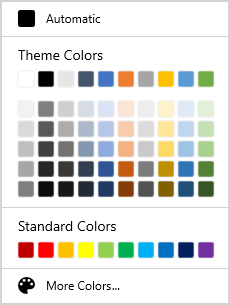
Reset the selected color
If you want to reset the selected color as No color or Transparent, click the No Color button. You can display the
No color button only by setting the ShowNoColorButton property value as true. The default value of ShowNoColorButton property is false.
<syncfusion:SfColorPalette ShowNoColorButton="True"
Name="sfColorPalette"/>sfColorPalette.ShowNoColorButton = true;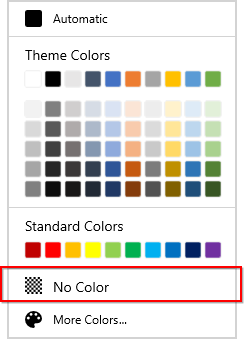
Setting default color
If you want to change the default selected color on application launching, set the value for AutomaticBrush property. If you changed the selected color, then you can easily make the default color as selected color by clicking the default color button. The default value of AutomaticColor property is Black.
<syncfusion:SfColorPalette AutomaticBrush="Red"
Name="sfColorPalette" />sfColorPalette.AutomaticBrush = new SolidColorBrush(Colors.Red);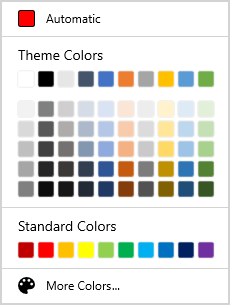
Hide default color button
You can hide the default color button visibility by setting the ShowDefaultColorButton property value as Collapsed. The default value of ShowDefaultColorButton property is true.
<syncfusion:SfColorPalette AutomaticBrush="Green"
ShowDefaultColorButton="False"
Name="sfColorPalette" />sfColorPalette.AutomaticBrush = new SolidColorBrush(Colors.Red);
sfColorPalette.ShowDefaultColorButton = false;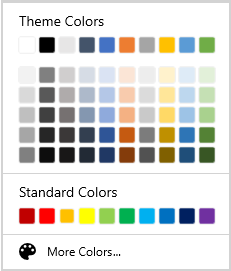
Selected color changed notification
The selected color changed in SfColorPalette can be examined using SelectedBrushChanged event. The SelectedBrushChanged event contains the old and newly selected color values in the OldBrush, NewBrush properties.
<syncfusion:SfColorPalette SelectedBrushChanged="SfColorPalette_SelectedBrushChanged"
Name="sfColorPalette" />sfColorPalette.SelectedBrushChanged += SfColorPalette_SelectedBrushChanged;//Invoked when the selected color is changed
private void SfColorPalette_SelectedBrushChanged(object sender, SelectedBrushChangedEventArgs e) {
var oldBrush= e.OldBrush;
var newBrush= e.NewBrush;
}Tooltip support
Tooltip is used to show the information about the segment, when you mouse over on the segment. You can show information about name of the color item using tooltip when hovering the mouse on the specific color item.

Recently used color items
The recently selected color items are displayed in the Recent Colors panel. If you want to choose a color which are previously selected, use the Recent Colors panel. You can get the recently selected color list by using the RecentColors collection property.
<syncfusion:SfColorPalette Name="sfColorPalette"/>SfColorPalette sfColorPalette = new SfColorPalette();
//Recently selected color list
var recentColors = sfColorPalette.RecentColors;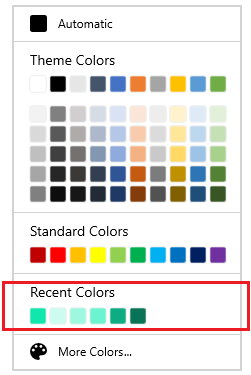
Setting the foreground
You can change the foreground color of the SfColorPalette by using the Foreground property. The default value of Foreground property is Black.
<syncfusion:SfColorPalette Foreground="Red"
Name="sfColorPalette" />sfColorPalette.Foreground = new SolidColorBrush(Colors.Red);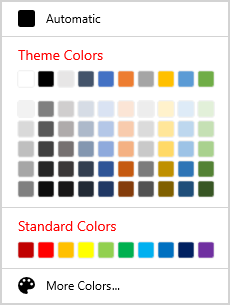
Setting the background
You can change the background color of the SfColorPalette by using the Background property. The default value of Background property is null.
<syncfusion:SfColorPalette Background="LightYellow"
Name="sfColorPalette" />sfColorPalette.Background = new SolidColorBrush(Colors.LightYellow);
Change flow direction
You can change the flow direction of the SfColorPalette layout from right to left by setting the FlowDirection property value as RightToLeft. The default value of FlowDirection property is LeftToRight.
<syncfusion:SfColorPalette FlowDirection="RightToLeft"
Name="sfColorPalette" />sfColorPalette.FlowDirection = FlowDirection.RightToLeft;
Change color palette size
You can change the color palette size by using the Width and Height properties. Based on the color palette size, the color items are resized. The default value of Width and Height properties is Auto.
<syncfusion:SfColorPalette Width="200"
Height="300"
Name="sfColorPalette"/>sfColorPalette.Width = 200;
sfColorPalette.Height = 300;
Hide the SfColorPalette
You can hide the SfColorPalette by setting the Visibility property value as Collapsed. The default value of SfColorPalette.Visibility property is Visible.
<syncfusion:SfColorPalette Visibility="Collapsed"
Name="sfColorPalette"/>sfColorPalette.Visibility = Visibility.Collapsed;